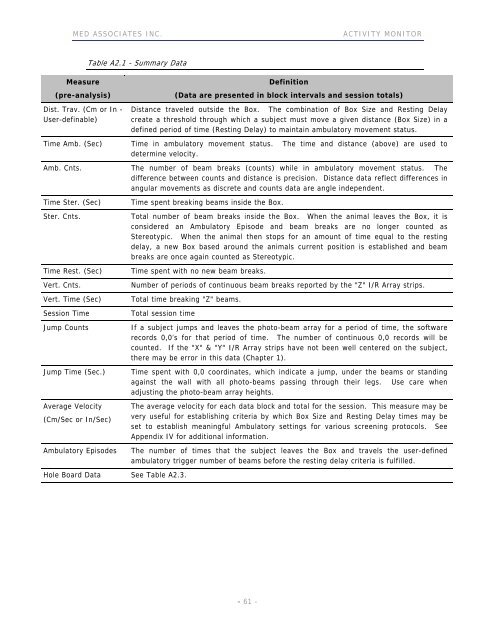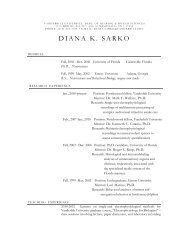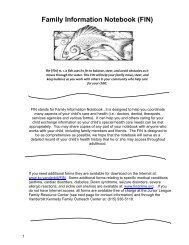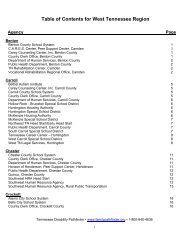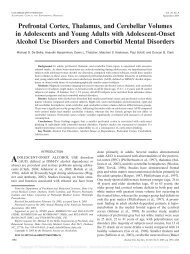ACTIVITY MONITOR - Vanderbilt Kennedy Center
ACTIVITY MONITOR - Vanderbilt Kennedy Center
ACTIVITY MONITOR - Vanderbilt Kennedy Center
You also want an ePaper? Increase the reach of your titles
YUMPU automatically turns print PDFs into web optimized ePapers that Google loves.
MED ASSOCIATES INC. <strong>ACTIVITY</strong> <strong>MONITOR</strong><br />
Measure<br />
(pre-analysis)<br />
Dist. Trav. (Cm or In -<br />
User-definable)<br />
Table A2.1 - Summary Data<br />
- 61 -<br />
Definition<br />
(Data are presented in block intervals and session totals)<br />
Distance traveled outside the Box. The combination of Box Size and Resting Delay<br />
create a threshold through which a subject must move a given distance (Box Size) in a<br />
defined period of time (Resting Delay) to maintain ambulatory movement status.<br />
Time Amb. (Sec) Time in ambulatory movement status. The time and distance (above) are used to<br />
determine velocity.<br />
Amb. Cnts. The number of beam breaks (counts) while in ambulatory movement status. The<br />
difference between counts and distance is precision. Distance data reflect differences in<br />
angular movements as discrete and counts data are angle independent.<br />
Time Ster. (Sec) Time spent breaking beams inside the Box.<br />
Ster. Cnts. Total number of beam breaks inside the Box. When the animal leaves the Box, it is<br />
considered an Ambulatory Episode and beam breaks are no longer counted as<br />
Stereotypic. When the animal then stops for an amount of time equal to the resting<br />
delay, a new Box based around the animals current position is established and beam<br />
breaks are once again counted as Stereotypic.<br />
Time Rest. (Sec) Time spent with no new beam breaks.<br />
Vert. Cnts. Number of periods of continuous beam breaks reported by the "Z" I/R Array strips.<br />
Vert. Time (Sec) Total time breaking "Z" beams.<br />
Session Time Total session time<br />
Jump Counts If a subject jumps and leaves the photo-beam array for a period of time, the software<br />
records 0,0’s for that period of time. The number of continuous 0,0 records will be<br />
counted. If the "X" & "Y" I/R Array strips have not been well centered on the subject,<br />
there may be error in this data (Chapter 1).<br />
Jump Time (Sec.) Time spent with 0,0 coordinates, which indicate a jump, under the beams or standing<br />
against the wall with all photo-beams passing through their legs. Use care when<br />
adjusting the photo-beam array heights.<br />
Average Velocity<br />
(Cm/Sec or In/Sec)<br />
The average velocity for each data block and total for the session. This measure may be<br />
very useful for establishing criteria by which Box Size and Resting Delay times may be<br />
set to establish meaningful Ambulatory settings for various screening protocols. See<br />
Appendix IV for additional information.<br />
Ambulatory Episodes The number of times that the subject leaves the Box and travels the user-defined<br />
ambulatory trigger number of beams before the resting delay criteria is fulfilled.<br />
Hole Board Data See Table A2.3.


